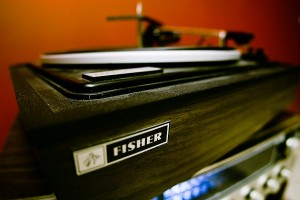Defining the parts of a turntable is actually a reasonably easy job compared to other audio and video components. A turntable is made up of five clear parts: the plinth (or base), the motor, the tonearm, the cartridge and the platter. Some people might disagree on whether the tonearm and cartridge form part of the ‘turntable’, but as they are required to actually play the music, we can safely include them as one of the parts of a turntable.
Parts of a Turntable – The Plinth
The word ‘plinth’ has certainly caught on as the word for the base of the record player. I’ll leave it to you to decide whether plinth is a pretentious word or not. Nonetheless, the plinth serves a crucial isolation function, as well as the obvious cosmetic function. There are various plinth designs to address both of these issues. A classic plinth is the wooden variety found on most vintage turntables, but they are also made of a variety of other materials. They essentially hold everything up, and a turntable could not ruin without some form of plinth as its electronics usually stick out the bottom side of the platter.
Parts of a Turntable – The Platter
The platter is the part of the turntable that the record sits upon. The platter is spun by the motor at various revolutions per minute (most commonly 33 and 45, and occasionally 78). A mat is often sat upon the platter to act as a buffer between platter and record, but this may not be necessary depending on the turntable. Platters are usually removable, and on some turntables such as the minimalistic Rega and Pro-ject designs, is necessary to change the speed at which the records are being played at.
Parts of a Turntable – The Motor

The motor is typically either a belt drive or direct drive design. There has been non-stop debate on belt drive vs direct drive for the past 40 years and there appears to now be somewhat of a cease fire between the two camps. Both motor types have their fans, and indeed the sound is often a little different between motor types. The justification for belt driven turntables is that the motor is better isolated from the platter due to the platter being rotated by a belt. In contrast, a direct drive turntable has the motor as part of the platter. Technics are the most famous developers of direct drive turntables. Instead of joining in the never-ending debate over which is best, please just accept that sound is far more a result of overall turntable design than which drive is used. There are excellent examples of both drive types. DJs will prefer direct drive turntables as they have much higher torque and therefore ‘spin-up’ faster.
Parts of a Turntable – The Tonearm
The tonearm is a deceivingly complex part of the turntable. In essence, it is a house for the cartridge, and designed to make the cartridge’s job of tracking the record as easy as possible. A tonearm will usually have a counterweight that allows the cartridge to be correctly balanced to allow idea playing ability, as different cartridges require different down-force (see: how to balance a tonearm). There are various tonearm designs, including s-shaped and straight tonearms. There is little difference between the two outside of aesthetics. DJs use a shorter, straight tonearm for scratching, but casual listeners and audiophiles should avoid these as they increase record wear and do not track as well as standard tonearm designs.
Parts of a Turntable – The Cartridge
The cartridge is the most debatable as being included as one of the parts of a turntable. Many turntable manufacturers shipped their record players with third party cartridges by companies such as Shure and Ortofon, as cartridge design is traditionally a different science altogether. Rega is a company that makes both turntables and cartridges, amongst other things. Turntable cartridges come in both moving magnet (MM) and moving coil (MC) designs. At a basic level, the cartridge creates an electrical signal in response to the stylus moving across the surface of the record. This sound is then amplified by a phono pre-amplifier and amplifier, which in turn drive the speakers to move and create sound.

Leave a Reply